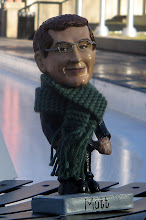All this week I've been rehearsing Mozart's Serenade in G, Eine Kleine Nachtmusik in a string quintet for a chamber music concert this Sunday. I guess it's fitting that in this year of overplayed Mozart, we should finish with one of the most overplayed Mozart pieces of all time. It's quite probable that, should a cell phone go off during the performance, it will play a ring tone from Eine Kleine Nachtmusik. It's one of those pieces you can hear so much you stop recognizing it as music. That's not to say it's a bad piece - like any Mozart work, there seem to be endless little surprises and miracles. It's up to us to make them seem that way, not overly familiar drudgery.
One of the things we've been talking about is vibrato. Apparently Sir Roger Norrington left a lot of us thinking about this subject; and while we're not ready to abandon it entirely, we're all trying to use it in a more thoughtful way. Probably this is something musicians alone obsess about - I've been trying to think of a similar conundrum in another profession, but haven't really come up with anything. Are there postal workers who feel a need to shake all the packages, or lawyers who can't stop palpitating their briefcases?
For musicians, the problem of vibrato is sort of the same as the problem of Eine Kleine Nachtmusik: they can both be so great and wonderful, as long as they are not done to death, or done in a perfunctory and boring way. One of the most interesting moments is near the end of the second movement, when the coda begins with a series of surprising modulating chords. We decided that we would make these chords most striking by using no vibrato at all, just playing them with a very fast and emphatic bow stroke. However, the danger is that they could still sound dead and dreadfully out of tune.
At our rehearsal today, coach Scott Nickrenz suggested that we "give those chords some life in the left hand" - which might sound like a euphemism for vibrato, but somehow thinking of it in this way helped. The sound had that shimmering resonant life, without the wobbly preciousness of a wide vibrato. Scott described this kind of active left hand as "salt and pepper", which conveys the size of the movement as well as its effect on the sound - a little can go a long way.
I think maybe semantics is a big part of the problem, since the word vibrato has gotten so loaded with sappy romantic connotations. Obviously we need in an infinite gradation of different vibrato sounds, from the slightest shimmer to the garish cafe vibrato that Sir Roger likes to joke about. Actually in his essay on orchestral vibrato, Sir Roger mentions Fritz Kreisler and the advent of continuous vibrato, writing that "listening to his recordings today one is struck by the delicacy of his vibrato. It is much more a gentle shimmer than the forced pitch-change one often hears today."
So maybe we need a thousand different words for vibrato, as the Eskimos allegedly have for snow. Next time Sir Roger comes around, we can say, "That's not vibrato, that's my vifructo!" And while we're tweaking our semantics, maybe we can call the piece tomorrow "Eine Kleine Nachmittagmusik", since we are playing it in the afternoon (the concert begins at 3 pm). Is there really anything nocturnal about this music? Who knows, it might make people sit up and listen with fresh ears - or at least silence the cell phone jingles!
Subscribe to:
Post Comments (Atom)


 Technorati Link Count: no. of blog reactions to this post
Technorati Link Count: no. of blog reactions to this post
1 comment:
I find myself returning often to Otto Klemperer's recording of Eine Kleine, which would probably make Sir Roger squirm. Somehow, though, there are so many riches in this piece (as you say) and Klemp has such a deep understanding of them, that his non-period manner remains a miracle, vibrato and all.
Post a Comment